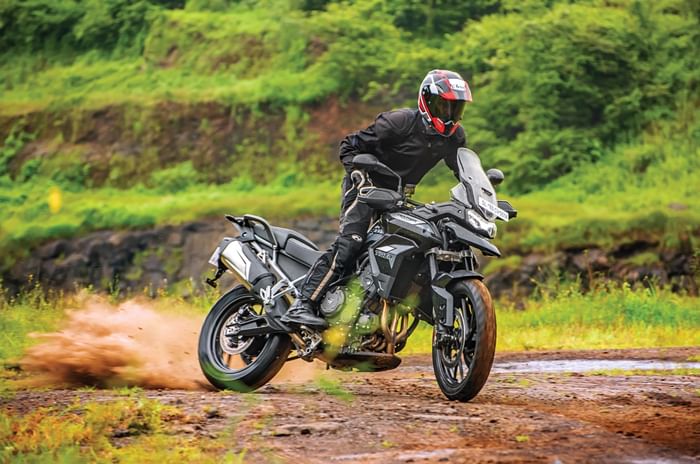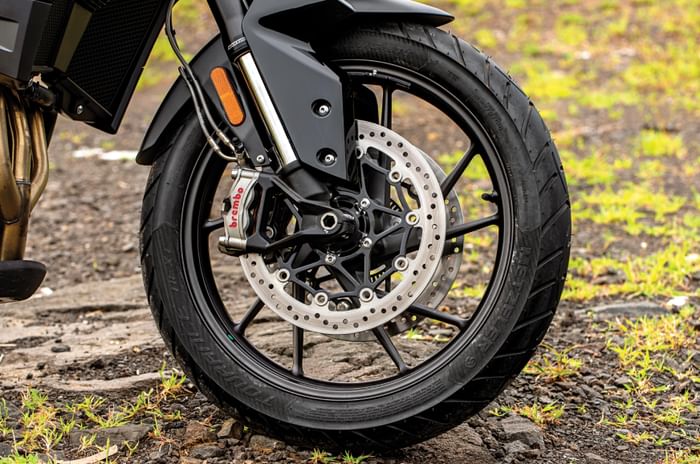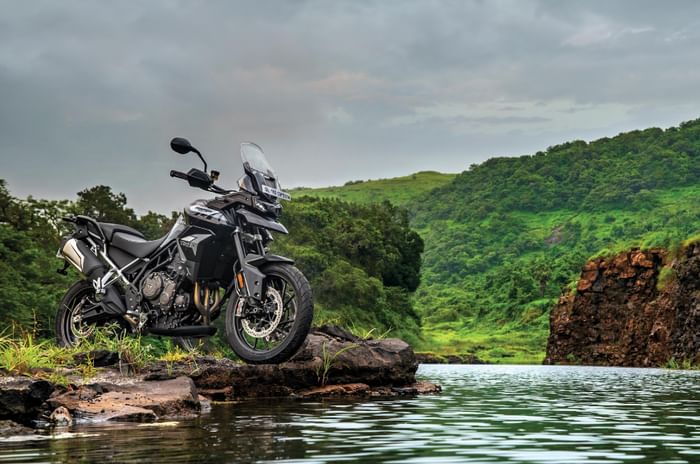Triumph Tiger 900 GT review, test ride
The new entry-level Tiger for India has much more to offer than its predecessor.
Published on Oct 14, 2020 08:00:00 AM
33,304 Views
Follow us on

Heated grips and cruise control are standard features.

Brakes get a big improvement.
Triumph tends to take a safe, evolutionary approach towards improving its machines, but the new Tiger 900 follows a different path. If you could ride it blindfolded back to back with the Tiger 800, you’d swear that you were on a completely different motorcycle, possibly even from a different manufacturer. When you do that to a motorcycle as popular (at least, in India) as the Tiger 800, you better make sure you get it right.

Leaner, meaner
Things start off well in the design department and even though the spec sheet doesn’t say this, the Tiger 900 GT immediately feels smaller and more manageable than the Tiger 800 XRx that it replaces. Viewed head-on, the new bike looks slimmer but has a taller and more purposeful stance from every other angle. The new Tiger is indeed wider, taller and has a longer wheelbase than the Tiger 800 XRx, but believe me, it just doesn’t feel that way in person. That’s because Triumph has worked hard to reduce the top-heavy feel of the old bike, even while they’ve increased the fuel-tank capacity from 19 to 20 litres.
We’ve already gone into all the details in our first ride review from Morocco earlier this year, but to briefly reiterate – Triumph has achieved this by moving the new engine forward and lower down. A new split-radiator setup and a smaller oil sump have helped them do so without making sacrifices to the ground clearance. Overall, the company claims a 6kg drop in dry weight, but it feels more like 10 or 15.
The easily adjustable new windscreen is slimmer too. It’s also much nicer than the old one because it allows more air to reach the rider while causing far less helmet buffeting at highway speeds. Finish levels and attention to detail are high and even the underseat area is neatly designed. The new exhaust sits closer to the bike, which will improve luggage fitment, and the large grab handle looks smart while remaining practical. There are two power outlets available, as well as a USB charging port under the rear seat.
The ergonomics are nice too, and the bike continues with its street bike-rivalling 810mm seat height that can be raised to 830mm. Shorter riders will love this, and tall folks will be just fine too; and, somehow, Triumph has made the riding position work while seated or standing on the pegs. The only complaint is that the triangular black plastic panel that sits ahead of the fuel tank inexplicably sticks out by a few mm and I find that my knee constantly rubs against this. A shorter rider had a similar experience and we both found it quite irritating.
Bigger, but better?
It’s now common knowledge that Triumph has changed the firing order of this new triple engine, while also raising the capacity from 800cc to 888cc. On paper, the gains are unimpressive – power remains identical, at 95hp, while torque goes up by just 8Nm. Clearly, the goal was to meet Euro 5 emissions norms, but the changes are vastly more apparent than the numbers suggest.

From the rider’s point of view, the engine now sounds more like a twin below 5,000rpm and there’s a mild pulsation that can be felt in the handlebar. The thrilling sportbike shriek of the old engine is gone and while this made me sad at first, I’ve grown to find that the deeper new sound is more in line with the character of an ADV bike. Better still, the bottom-end and mid-range performance is now tangibly stronger than the old bike and this is good news for off-road work or quick highway overtakes. The engine also remains super tractable and you can lazily ride in 6th gear at 40kph with no hassles.
What’s not good news is that the new engine just isn’t as smooth and rev-happy. Once you cross 120kph, that pulsation in the bars and pegs turns into vibration, and this is something that only builds with speed. To be fair, it isn’t terribly harsh, but it is clearly noticeable and it’s also something we’ve never experienced on the Tiger before.
In terms of heat, the old Tiger’s chassis would get really hot in the heavy city traffic and while the Tiger 900 runs very hot too, it isn’t quite as bad, because your legs don’t come in direct contact with the slimmer new frame. Strangely though, in scorching afternoon heat at highway speeds, we found that the new split radiator sends a steady blast of hot air directly onto the left knee. We haven’t been able to take this bike on a long tour, so I can’t tell you if this hot air stream persists for long durations, but it’s something that needs to be evaluated.
Regardless of the heat, what’s clear is that the new Tiger is a significantly quick machine, even more so than its predecessor. So, you’ll be happy to know it also gets a significant upgrade in the braking department. This bike runs Brembo’s superbike-spec Stylema calipers, but with a J Juan master cylinder. They’re not superbike sharp but they offer great feel and progression as you build pressure on the lever, and are a very good fit for this bike.
Keep on rolling
Something else to appreciate is the new, higher-spec suspension by Marzocchi, which is now adjustable and also gets a convenient remote adjuster for the rear suspension preload. This is a great addition since adjusting the preload on the old bike was a very tedious affair. The new suspension works well, and while it is set up a little more firmly than the old bike, the adjustability will allow you to bring in some more suppleness.

With its wide and supportive seats, the Tiger 900 GT is superbly comfortable, and it can cover ground at high speeds in an effortless manner. The handling has also improved over the old XR, with a more connected feel from the front end and a little more clearance before the foot pegs begin to grind tarmac.
As for bad roads, well, you can ride it through the worst India has to offer and the Tiger will just shrug it off. With its 19-inch alloy wheels and road-biased Metzeler tyres, the GT is the road-focused version in the Tiger line-up, but it can still take on a fair amount of off-road riding. There’s about 180mm of suspension travel and ground clearance available, and the bike gets a light plastic guard for the sump.
You can have quite a lot of fun jumping and sliding this bike about and it will easily take on a trip to Ladakh as well. But if you really want to go hardcore with your off-roading, you’ll want the Tiger 900 Rally, with its spoked rims, additional suspension travel and 21-inch front wheel. For most casual ADV riders, though, the 900 GT is plenty capable.
Got smart
The Tiger 900 gets a big boost in the electronics department, including lean-angle-sensitive traction control and ABS. The new 7.0-inch TFT display is huge and has four different layouts to choose from, all of which are quite quirky. Using Bluetooth, you can manage your music, navigation and even control a GoPro through the display, but you will have to buy a Rs 21,000 accessory module to enable these features.

The 900 GT here is the lowest-spec model in the line-up, but it’s still well equipped, with things like a powerful LED headlamp, heated grips, cruise control and four riding modes. In the off-road mode, you can deactivate the rear ABS and the traction control, which is all you need. The only electronic feature I missed was a quick-shifter.
At Rs 13.7 lakh (ex-showroom, India), the Tiger 900 GT costs Rs 40,000 more than the Tiger 800 XRx and gives you a whole lot more for the price. If Triumph had made this new motor a little bit smoother in the higher reaches of the rev range, we’d be singing from the rooftops about this motorcycle. Nevertheless, as an overall package, the Tiger 900 GT is a full-size ADV that is approachable to a wide group of riders and is a really nice bike to ride in our conditions.
Tech Specs 
Copyright (c) Autocar India. All rights reserved.


 Wheels and Tyres
Wheels and Tyres Dimensions & Chassis
Dimensions & Chassis Price
Price Engine
Engine Transmission
Transmission Suspension
Suspension Brakes
Brakes
Comments
Member Login
Personal Details
No comments yet. Be the first to comment.